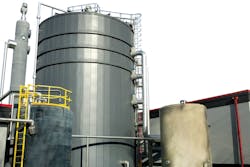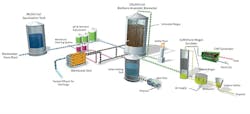Capitalizing on the food-water-energy nexus through wastewater treatment
The menu of reasons for food and beverage processing firms to reduce water usage and capitalize on the food-water-energy nexus is extensive.
As drought conditions and water pollution crises multiply, water is no longer viewed as a free commodity in processing environments. According to the United Nations, one-fifth of the world’s population lives in water-scarce areas; another 25 percent are already facing water shortages; and the food sector uses 70 percent of the world’s freshwater supplies. The food and beverage (F&B) industry’s reliance on the water as a direct ingredient and an input to agricultural production makes it particularly vulnerable to the problem of dwindling water supplies.
Industry challenges
Multiple pressures are driving F&B companies to improve their stewardship of the resource, including:
- Water costs: As resources become more constrained, consumption and discharge costs are projected to rise and even skyrocket in areas subject to water shortages.
- Energy costs: Lowering water costs can also mean reducing the cost of energy used for heating or cooling water.
- Water scarcity and environmental protection: Growing public concern about water consumption and pollution are resulting in increasingly stringent regulatory controls.
- Operational risk: Water scarcity and stricter regulations can directly hamper the operations of F&B producers.
- Reputational risk: Valuable F&B company brands are vulnerable to damage as stakeholders challenge their water policies and practices.
- Demand growth in emerging markets: Expanding middle and upper classes in emerging markets is increasing demand for branded processed food and drink. Companies are investing in water technology to ensure the safety and reliability of their products and avoid conflict with host communities over water resources.
- Improving technology: Opportunities to recover energy and materials and to reuse water for processing are making water technology investment increasingly cost-effective and even profitable.
These and other forces are fueling growing expenditures in water technology by F&B companies, with investment estimated to grow to $6 billion by 2020.
Putting the food-water-energy nexus to work
One area of investment where F&B companies have found significant, possible headway is wastewater management. New technologies make it possible to reduce water usage and improve water effluent discharges while also generating renewable energy.
F&B producers typically have high-strength and high-solids wastewater streams. As a result, manufacturers need wastewater treatment processes that are reliable, effective, flexible and easy to operate.
One such solution is an anaerobic membrane bioreactor (AnMBR). The system simplifies wastewater treatment by combining multiple treatment needs into a single system. It enables food and beverage companies to generate a high-quality effluent that can be easily treated for reuse or direct discharge, thus conserving water, complying with discharge regulations and reducing sewer fees. In addition to being a highly effective wastewater treatment technology, the system is also designed to maximize the creation of biogas. This essentially transforms the company’s waste into green energy that can reduce energy costs and support corporate sustainability initiatives, thus putting the food-water-energy nexus to work.
To date, Veolia Water Technologies has commissioned 10 full-scale AnMBR installations worldwide for the treatment of industrial wastewater with relatively high chemical oxygen demand (COD) concentration: five at dairies, four for food production, and one for a bioethanol plant.
AnMBR key differentiators:
- Treatment of high-strength streams (COD 15,000 ~ 250,000 ppm)
- Stable and robust anaerobic biological process
- Excellent effluent (permeate) quality
- Green energy production from highest possible biogas yields
- Easy to operate, fully automated
- Low operating costs
- Compact solution
AnMBR advantages:
- Rapid return on investment; low operational cost
- Completely automated, robust and reliable operation
- Minimal pretreatment requirement
- High tolerance for fats, oils and grease and suspended solids
- No need for primary solids disposal from pretreatment
- Maximum energy recovery from biogas
- No need for biogas scrubbing to keep membranes clean
- Superb solids-free effluent quality with BOD comparable to aerobic treatment
- Easy recovery of nutrients from effluent
- Minimizes sludge disposal costs
- Reduces environmental footprint
- Odor-free operation
Case study: Snack producer beefs up energy production
A leading protein snack producer in the Dakotas faced a high biochemical oxygen demand (BOD) discharge issue at its facility. For years, effluent exiting the system had been discharged directly to the sewer system of the local municipality. Increased production and high BOD were contributing to an overload of the city’s municipal treatment plant, and a new approach was needed.
In response, the company adopted a Veolia-designed solution combining its AnMBR technology with its biogas desulfurization system. In addition to solving the effluent discharge issue, the treatment process also generates biogas as a byproduct to reduce the plant’s energy costs.
The valuable methane-rich biogas produced from the AnMBR system is treated by Veolia’s biogas desulfurization system. This treatment step removes sulfur compounds from the biogas, which are highly corrosive and can damage downstream equipment. The scrubbed biogas is then sent to a combined heat and power (CHP) generator to produce electricity for plant operations and offset energy costs.
Since the installation, the performance of the treatment process has surpassed expectations. Discharges to the city treatment plant have been stabilized. The consistent, high-quality effluent has eased the overloading and contributed to a significant improvement in the municipal facility’s operations.
In addition to the wastewater improvement, the energy recovery made possible by the treatment system has contributed to improving the plant’s economics. The biogas byproduct produced in the anaerobic reactor at full flow generates more electricity than the system consumes. The energy-positive result has meant a fast return on the capital investment for the plant. A less quantifiable result is the goodwill fostered by showing the facility to be a good neighbor in its community because of its proactive implementation of this environmentally sound solution.
Case study: Dairy companies milk resources from wastewater
As global demand for milk, cheese, yogurt and other dairy products continues to grow, cost and energy management concerns are driving the introduction of new technologies in dairies to optimize and control costs of water usage.
In Aylesbury, UK, Arla Foods required advanced wastewater treatment and water recycling facilities for its new 150m dairy. Arla Foods is a global dairy company and a cooperative owned by dairy farmers with production facilities in 12 countries. Its fresh milk processing facility in Aylesbury processes 1 billion liters of milk annually. Each day, the plant treats 132,000 gallons of wastewater containing 5.9 tons of COD.
Arla’s goal was to create the world’s first zero-carbon fresh milk processing facility. The company evaluated the dairy’s potential impact on the environment and committed to using the best available construction techniques, advanced process technologies and cutting-edge renewable energy opportunities.
To achieve Arla’s objective, Veolia Water Technologies installed its biogas AnMBR system in the facility’s wastewater treatment plant. The reactor ensures preferential removal of inorganic solids and optimizes performance to remove up to 99 percent of the COD. Low-strength wastewater and greywater is treated in a reverse-osmosis plant and recycled to the dairy for clean-in-place applications, eliminating disposal costs. Methane-rich biogas generated by the process is used to fuel the on-site CHP plant, enabling Arla to put the food-water-energy nexus to work and achieve its carbon-neutral goal.
In the food and beverage sector, a multi-faceted wastewater solution is helping pace-setting companies cut consumption and clean up their effluent while generating green energy.
Woodlands Dairy in Humansdorp, South Africa, sought a viable processing solution for its growing process effluent stream. Woodlands Dairy is a local, Eastern Cape processor of farm fresh milk and producer and packager of high-quality dairy products. With more than 1,000 employees, the facility contains a milk sterilization and packaging plant as well as a cheese factory. Woodlands is one of the largest manufacturers of ultra-high temperature processing milk in South Africa. The company is committed to the use of dairy farming methods that have a minimal impact on the environment and are animal-friendly.
Woodlands needed a solution to its growing effluent demand that was generating high COD loading of 16.5 tons per day. In response, Veolia proposed a resource recovery plant (RRP) capable of processing 396,000 gallons per day. The RRP uses AnMBR technology to remove more than 95 percent of effluent COD. A piloting study was performed to design a specific effluent treatment facility ensuring product performance. Inaugurated at the end of 2016, the new plant has enabled Woodlands to exceed municipal discharge requirements while generating 1.8 megawatts (MW) of energy through biogas generation.
Food-water-energy nexus opportunities
While the case studies presented here are impressive, the capabilities of the technologies described are not limited to meat and dairy processing. The science behind this food-water-energy nexus technology can be applied to any high-BOD wastewater from a variety of food and beverage products – with the possibility of recouping costs through energy production, improving brand, and achieving sustainability goals.
Rob Frankin has more than 31 years of experience in the development and commercialization of water treatment technologies. Frankin’s current role at Veolia Water Technologies North America is to lead the commercialization efforts for Veolia’s biological wastewater treatment technology portfolio, which includes Biothane anaerobic treatment, AnoxKaldnes MBBR (Moving Bed Biofilm Reactor), and NEOSEP MBR (Membrane Bioreactor). Prior to his commercialization role in the U.S., Frankin was the managing director at Veolia’s Biothane technology center for high-rate anaerobic treatment.





